Ed Wood Blu-ray Movie
HomeEd Wood Blu-ray Movie 
Disney / Buena Vista | 1994 | 127 min | Rated R | Sep 18, 2012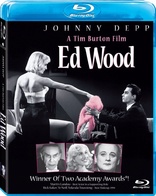
Price
List price:Amazon: $8.55 (Save 14%)
Third party: $8.55 (Save 14%)
Temporarily out of stock. We are working hard to be back in stock. Pla
Movie rating
8.3 | / 10 |
Blu-ray rating
| Users | 4.2 | |
| Reviewer | 4.0 | |
| Overall | 4.2 |
Overview
Ed Wood (1994)
The true-life story of Ed Wood, famed as the worst director in the history of Hollywood, but at heart an enthusiastic movie fan with a passion to create.
Starring: Johnny Depp, Martin Landau, Sarah Jessica Parker, Patricia Arquette, Bill MurrayDirector: Tim Burton
| Dark humor | Uncertain |
| Biography | Uncertain |
| Period | Uncertain |
| Drama | Uncertain |
| Comedy | Uncertain |
Specifications
Video
Video codec: MPEG-4 AVC
Video resolution: 1080p
Aspect ratio: 1.85:1
Original aspect ratio: 1.85:1
Audio
English: DTS-HD Master Audio 5.1 (48kHz, 24-bit)
French: Dolby Digital 5.1 (640 kbps)
Spanish: Dolby Digital 2.0 (320 kbps)
Subtitles
English SDH, French, Portuguese, Spanish
Discs
50GB Blu-ray Disc
Single disc (1 BD)
Playback
Region free
Review
Rating summary
| Movie | 4.5 | |
| Video | 4.0 | |
| Audio | 4.0 | |
| Extras | 4.0 | |
| Overall | 4.0 |
Ed Wood Blu-ray Movie Review
Waiting for Burton
Reviewed by Michael Reuben September 17, 2012Ed Wood is the closest thing Tim Burton has ever made to an art house film. It never played in more than 623 theaters, and its box office didn't come close to making back its modest $18 million production budget (thereby apparently vindicating the decision by Columbia's studio head to jettison the project, when Burton insisted on filming it in black-and-white). Still, the film did give Disney the bragging rights of two Oscars, one for supporting actor Martin Landau's multifaceted embodiment of horror icon Bela Lugosi and one for makeup (including Rick Baker's prosthetics). The film's stature and its fan base have grown over time, as more viewers have come to appreciate its oddball aesthetic and fantastical yarn, more truth than fiction, anchored by what remains one of Johnny Depp's finest performances. If Depp had been the marquee star then that he is now, Disney would have opened the film a lot wider. The name Ed Wood is legendary. Even people who haven't seen any of his films know him as the Worst Director in History. Burton and screenwriters Scott Alexander and Larry Karazweski knew all of Wood's films, because they shared a passion for schlock cinema. As Burton says on the commentary track, there's a fine line between quality work and junk, and the implication is that anyone who walks that line on a regular basis can easily become intrigued by someone who routinely stepped off in the wrong direction. When Burton saw the writers' first draft of what became Ed Wood, he wanted to shoot it immediately. No one other than Burton could have made Ed Wood, but it doesn't look like any Burton film to date. The art direction that recreated Fifties L.A., as well as some of Wood's most infamous howlers, is as impressive as anything in Burton's fantasy films, but Burton departed from his usual practice of storyboarding every shot. This was primarily a character piece, and Burton wanted to focus on working with the actors and letting the scenes evolve from the cast's interaction (an aspect of Burton's skill as a director for which he gets too little credit). Thanks to Burton's sensitive direction, the inventive script by Alexander and Karazweski and a pitch-perfect ensemble, the wandering narrative always returns to its main subject, which was Wood's boundless enthusiasm for the movies. It was his only qualification to be a filmmaker.
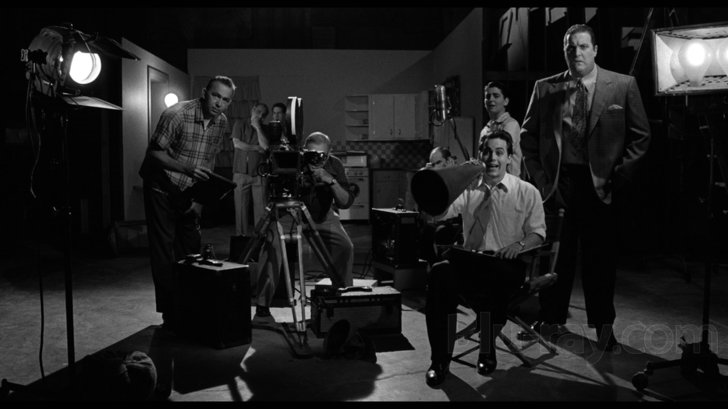
Ed Wood recounts the making of three of Wood's most famous turkeys, during the period from 1953 through 1959. The first is the transvestite epic, Glen or Glenda, in which Wood (Depp) himself stars, and which is supposed to be a quickie exploitation flick for George Weiss (Mike Starr), proprietor of "Screen Classics", who, unlike Wood, has zero artistic aspirations. The second, ultimately called Bride of the Monster, is self-financed and prompts Wood's break-up with his long-time girlfriend Dolores Fuller (Sarah Jessica Parker), after Wood gives away her leading role to a woman he's just met, Loretta King (Juliet Landau). Wood mistakenly believes King to be a wealthy heiress, but she isn't, and Wood's relationship with Fuller is already rocky after he confesses to her that all her missing clothes are in his closet, because he enjoys wearing them. The third film, the infamous Plan 9 from Outer Space, is financed by a Baptist church, which Wood persuades to produce the film so that its success can underwrite the elders' dream of funding a cycle of films about the twelve apostles. Of course, the entire cast and crew have to join the congregation. As Wood's friend, the aspiring transsexual Bunny Breckenridge (Bill Murray), marvels: "How do you do it? How do you get all your friends to get baptized just so you can make a monster movie?" It's while Wood is trying to land the directing job for Glen or Glenda that a chance encounter leads to his friendship with Bela Lugosi (Landau), which is the film's emotional core. Lugosi is elderly, frail, broke, addicted to morphine and bitter over his faded career. Wood sees all this, but puts it aside, because he see something else: a movie star, and what's more, a movie star he can put in his pictures. As their relationship deepens, the self-deluded director and his disillusioned idol establish an odd co-dependency that's almost a parody of the bond between fan and star. Wood needs to believe in Lugosi's greatness, and Lugosi needs Wood's belief in him. Their scenes together are sad, funny, disturbing and poignant, all at the same time. Show business has always attracted eccentrics and outcasts, but the group that forms around Wood is bizarre even by Hollywood standards. In addition to Bunny Breckenridge, Wood collects a massive Swedish wrestler, Tor Johnson (WWE Hall of Famer George "The Animal" Steele), who never spoke on camera because of his heavy accent; a local TV host of horror movies, Vampira (Lisa Marie), who considers herself too big for Wood's projects until she gets fired, and then asks for a non-speaking part in the hope her former fans won't recognize her; Criswell (Jeffrey Jones), a semi-famous psychic, who knows full well it's all hokum; Cameraman Bill (Norman Alden), who's color blind; a chiropractor named Tom Mason (Ned Bellamy), who doubled for Lugosi with a cape masking his face so that Wood can recycle old footage and claim that his film still "features" the great star, even after he is no longer available; and the inadvertent comedy team of Paul Marco and Conrad Brooks (Max Casella and Brent Hinkley), grips and Jacks of all trades, who barely know what they're doing but are happy to be working in pictures. Dolores Fuller is the only sane one in the group, and when she finally snaps and tells them they're all nuts, it comes off as an act of cruelty. After Fuller leaves him, Wood has the good fortune to meet Kathy O'Hara (Patricia Arquette), who looks like Dolores but accepts him for who he is. (They eventually marry.) At the center of the storm is the clueless auteur himself, who in real life was probably a handful, but in Depp's portrayal is irresistibly winning with his "can do" enthusiasm and his unshakeable faith that the next film will turn out better. Depp is well known for taking inspiration from unexpected sources, and he has said that his Ed Wood was drawn from The Wizard of Oz's Tin Man, American Top 40 announcer Casey Kasem and President Ronald Reagan. It's hard to imagine what inner resources allowed the real Ed Wood to maintain so much optimism in the face of constant failure and rejection, but the screenwriters suggest one possibility late in the film, when a frustrated Wood storms off the set of Plan 9 and heads straight for the nearest bar. Whom should he find there but his idol, the great Orson Welles (Vincent D'Onofrio), sitting quietly with a drink and a cigar, writing away on a script. Their conversation is brief, but a few words of encouragement from Welles are enough to send Wood back to the set with renewed energy. No such meeting ever happened, but Burton shoots the sequence with a surreal quality that suggests it's a vision or a daydream. (The sensation is enhanced by the overdubbing of D'Onofrio's voice with that of Maurice LeMarche, who sounds more like Welles—and the overdub doesn't quite match.) The real Wood probably spun himself a few such tales in his effort to keep pushing forward, and look where it got him. Over a half century after these films were made, people are still talking about them.
Ed Wood Blu-ray Movie, Video Quality 
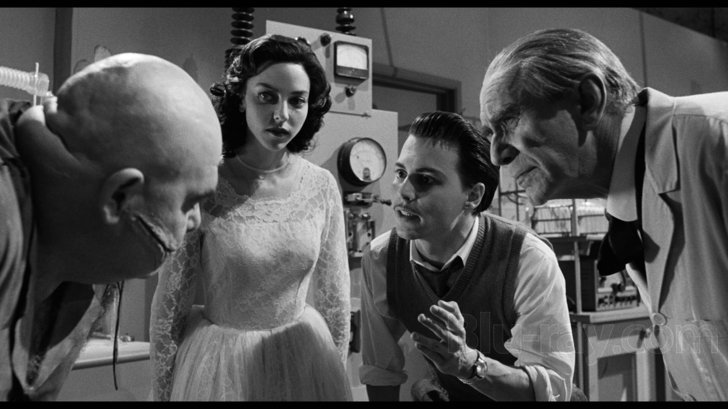
In 1994 it was still possible for cinematographer Stefan Czapsky to shoot black-and-white stock and have it professionally processed, but the technical facilities would disappear within the next few years. (In 2001, when the Coen Brothers decided to shoot The Man Who Wasn't There in B&W, DP Roger Deakins had to shoot it on color stock, then remove the color in post-production.) Burton and Czapsky had experimented with a desaturated, monochromatic style in Batman Returns, but according to Burton's commentary, they realized that B&W was essential for Ed Wood when it came time to develop the makeup for Bela Lugosi, and no one could find a reference for how Lugosi should look in color. With a few minor issues, Disney's 1080p, AVC-encoded Blu-ray joins the ranks of superior B&W renderings in hi-def, combining deep blacks with finely differentiated shadings of gray that allow for superior delineation of detail on such crucial items as, e.g., the fur of the angora sweaters that Wood found so sensually stimulating, as well as Lugosi's deteriorating physical condition and the meticulous recreations of Wood's tacky sets. Sharpness is consistently excellent without artificial enhancement, and the film's grain pattern appears natural and undisturbed. The only negative is occasional video noise, somewhat like aliasing, but more limited and contained, that appears in the occasional fine pattern. I saw maybe three or four instances of this during the film's entire running time, but it was a reminder that even Blu-ray's resolution has its limitations. (So, too, does 2K digital projection, because I sometimes see the same phenomenon there.)
Ed Wood Blu-ray Movie, Audio Quality 

Ed Wood's DTS-HD MA 5.1 soundtrack is excellent, but it's an entirely front-centered mix. The sound editing, like many other technical elements, including the cinematography, was deliberately crafted not to seem too modern. Accordingly, the rear channels are used almost exclusively to support Howard Shore's inventively goofy and, at times, genuinely tragic score. (This is the rare Tim Burton film not scored by Danny Elfman.) The dialogue is always clear.
Ed Wood Blu-ray Movie, Special Features and Extras 
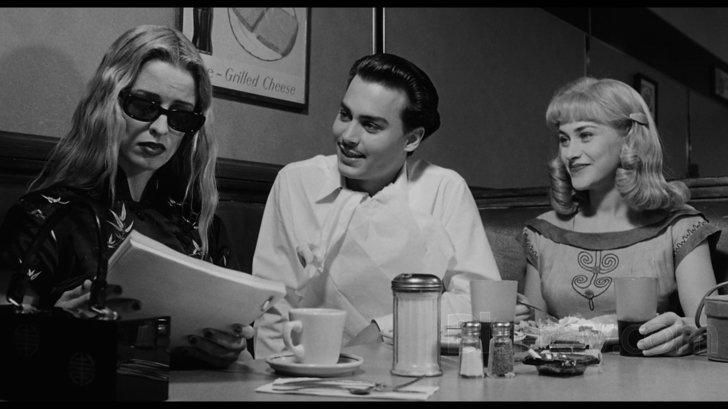
The extras have been ported over from the 2004 "special edition" DVD. All of the extras from that release have been included. (Two earlier releases were pulled prior to street date due to reported rights issues with one or more extras that had to be removed.)
- Commentary with Director Tim Burton, Actor Martin Landau, Co-Writers Larry Karaszewski and Scott Alexander, Director of Photography Stefan Czapsky and Costume Designer Colleen Atwood: This isn't a typical commentary, but a series of individual interviews edited together. Screenwriters Alexander and Karaszewski were interviewed jointly, but other subjects were interviewed alone. Some of the interview material overlaps with that of other extras (e.g., Landau's initial description of Lugosi). The only interviewee who appears to have been watching the film while he talked is DP Czapsky, who provides interesting insights on the technical challenges of specific shots; especially noteworthy is the final scene between Wood and Lugosi, where Czapsky went to great lengths to lay dolly tracks so that he wouldn't have to use a steadicam, because that would make the shot feel too "modern". In addition to providing his own comments, Landau introduces each commentator's initial segment in character as Bela Lugosi.
- Deleted Scenes (SD; 1.85:1, enhanced; 7:39): There are five scenes. Two extend the theft of the giant octopus. Another offers a glimpse of Tor Johnson's home life. The best is an additional scene between Wood and Lugosi. The strangest is a scene involving Bunny Breckenridge and the mariachi band seen briefly at the wrap party for Bride of the Monster.
- Music Video Composed by Howard Shore (SD; 1.33:1; 3:27): The music is Shore's title theme, and Toni Basil's campy choreography fits right in.
- Let's Shoot This F#*%@r! (SD; 1.33:1; 13:55): Depp provides an introduction and conclusion, but most of this featurette consists of neatly edited footage from the set. By far the best section chronicles the shooting of Lugosi's "octopus" encounter.
- The Theremin (SD; 1.33:1; 7:24): Howard Shore discusses the use of this unique electronic instrument in the score, and theremin expert Mark Segal describes how the instrument works.
- Making Bela (SD; 1.33:1; 8:14): Martin Landau and Rick Baker on the re-creation of Bela Lugosi.
- Pie Plates Over Hollywood (SD; 1.33:1; 13:49): Tom Duffield discusses the challenges of the film's production design.
- Theatrical Trailer (1994) (SD; 1.33:1; 2:19): Brief and clever.
- Sneak Peaks: At startup the disc plays trailers for Frankenweenie and ABC TV on DVD, plus an anti-smoking PSA. The main menu has an option for "Sneak Peeks" that plays these trailers, plus trailers for Who Framed Roger Rabbit on Blu-ray, Castle: Season 4 and ABC TV on Blu-ray.
Ed Wood Blu-ray Movie, Overall Score and Recommendation 
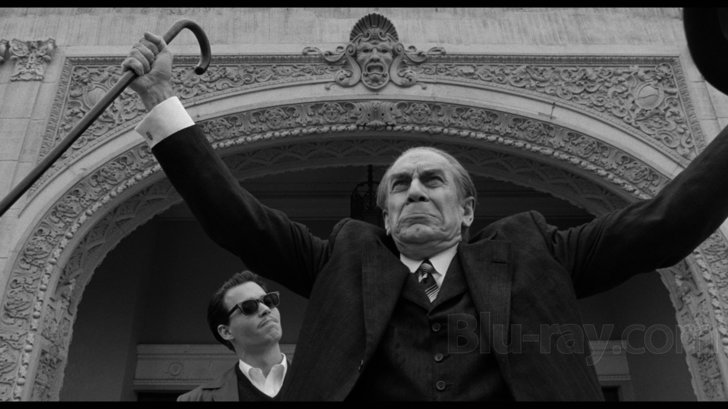
Being pigeonholed is one of the great hazards of Hollywood. Screenwriters Alexander and Karaszewski were typecast as writers of family comedy after their initial success with the Problem Child franchise. To break out of that mold, they wrote Ed Wood, after which they became known as "bio-pic" guys, and went on to write The People vs. Larry Flynt and The Man in the Moon. Radical action is sometimes what it takes to redefine someone. In the case of Ed Wood, it took Tim Burton, Johnny Depp and two clever writers to redefine the Worst Director in History into the hero of his own life story. Highly recommended.
Similar titles
Similar titles you might also like

Once Upon a Time in Hollywood 4K
2019

Birdman
Birdman or (The Unexpected Virtue of Ignorance)
2014

Jojo Rabbit
2019

The Banshees of Inisherin
2022

Mars Attacks!
1996

Confessions of a Dangerous Mind
2002

The Death of Dick Long
2019

Calvary
2014

World's Greatest Dad
2009

Wrong
2012

The Big Short
2015

Monty Python's Life of Brian
The Immaculate Edition
1979

Filth
2013

The King of Comedy
1982

Adaptation. 4K
2002

The Royal Tenenbaums
2001

Four Lions
2010

Network
1976

Swimming to Cambodia
Spalding Gray's Swimming to Cambodia | Standard Edition
1987

Four Rooms 4K
1995